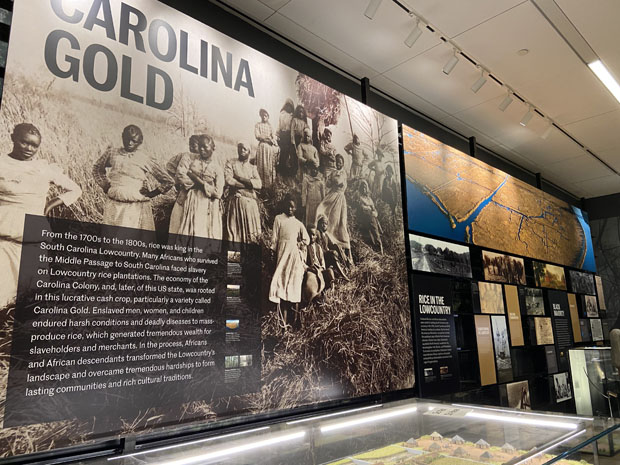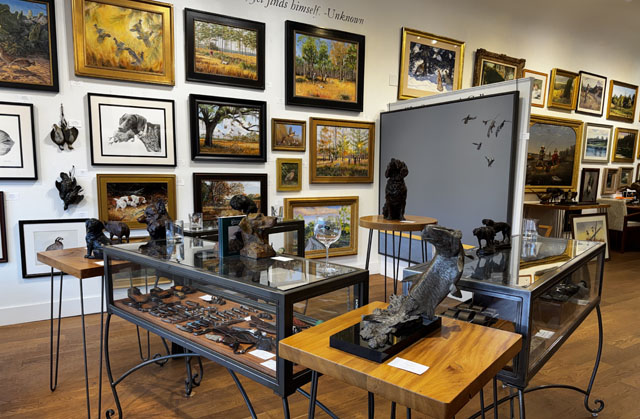Telling Untold Stories
04 Jan 2023
Chief learning and engagement officer at The International African American Museum aims to create deeper connections
Article and photos by Jenny Peterson

Malika Pryor-Martin has fond and powerful memories visiting museums as a child growing up in Detroit. Both the Museum of African American History and Detroit Institute of Arts Museum provided a sense of place and belonging.
“I attended youth arts programming that would take us to the museums and the magic was I was 8 years old,” Pryor-Martin said. “There was never a time in my life where I didn't think I belonged in cultural arts institutions, and I was absolutely shaped by the experiences that I had there.”
She took her love for history and art and turned it into a career. She started at the Charles H. Wright Museum of African American History—the museum where she had such fond memories—working in educational programs and curating exhibitions that inform and inspire.
She then moved internationally, working at National Art Gallery of The Bahamas, leading the communications and education team to make museum content accessible and impactful.
In her professional journey, she earned a law degree and became an educational programming consultant. As senior director of education and programs at the Detroit Historical Society, she spearheaded a dynamic, self-directed walking tour of Detroit’s historic Black Bottom neighborhood.
With her vast experience in curation and education, Pryor-Martin was recruited to join the International African American Museum (IAAM) in Charleston as Chief Engagement Officer, a position that combines curation, educational programming and community engagement events among the museum galleries and the African Ancestors Memorial Garden.
Twenty-three years in the making, the IAAM is set to open in early 2023, bringing guests on a moving journey that acknowledges the achievements of these African American individuals, exhibiting how their labor, resistance and ingenuity has shaped every aspect of our world today.
Pryor-Martin’s job is to broaden the experience of museum visitors by enhancing the stories and untold stories of the African American experience. That includes presenting information at the museum's location on one of the country's most sacred sites— Gadsden's Wharf, which once served as the country’s most prolific slave trading ports. It’s a role she doesn’t take lightly.
“I've been following IAAM since the announcement of the groundbreaking,” said Pryor-Martin. “As an African American studies major, I had a sense of the significance of Charleston within the context of the African American narrative and when I learned more about Gadsden's Wharf I thought, ‘what power there is there.’ It's estimated that every single African American with historical ties to the United States had at least one ancestor who traveled through Charleston.”
She is helping bring a wider interpretation of the museum’s materials—which includes artwork, historical documents, photos that have been donated, unearthed and/or acquired by the museum—to different learners by incorporating technology and, in some cases, telling stories rather than a historical timeline.
“How can we facilitate the greatest number of authentic points of entry for individuals, for communities, for the groups visiting the museum to be in conversation with the work?” Pryor-Martin said. “With how much content there is, it's still being presented in a visually-compelling way. You’ll want to stick around for the story. You're going to go, ‘Wait a minute, what happened in Brazil? How did this thing in Haiti connect to Charleston?’”
Making Connections
Ralph Appelbaum Associates, one of the world's longest-established and largest museum exhibition design firms, was tasked with the primary design of the museum’s exhibitions and Cortina Productions creative media design and production company worked with the museum on the digital and technology side, Pryor-Martin said.
Exhibitions at the IAAM include the hyper-local Gullah Geechee gallery, Carolina Gold Rice and South Carolina Connection Gallery. There is also an African Roots and African Routes exhibition—two exhibits in one gallery that explore the history of indigenous African empire cultural systems, spirituality, economy, relationships and other cultures of West and West Central Africa that can still be seen today.
“Derivative practices within the African American community can be linked to rituals, customs and prayer. It's really powerful that enslaved African Americans could not only (learn to) survive but do more than survive. Those are the human threads,” Pryor-Martin said.
An exciting and unique part of the museum is the Center for Family History, a family genealogy center where museum guests are able to search their family history by last name on kiosks.
“Visitors to the museum will have that same depth of access to all of their records that would otherwise only be available at a family search center,” Pryor-Martin said.
There is a theater in the museum and space for special exhibitions which will rotate several times a year. Underneath the museum is the African Ancestors Memorial Garden, which reflects on the historic significance of Gadsden’s Wharf with a powerful art installation etched into the concrete.
Pryor-Martin said a line of steel will mark the beginning of the wharf for a powerful reflection of the journey of enslaved African Americans.
“We are literally standing at the beginning of this side of their journey,” Pryor-Martin said.
Untold stories
As a lifelong museum supporter and exhibition creator, Pryor-Martin’s passion for her work at the IAAM is to shine a light on untold, underrepresented stories of enslaved African Americans and lesser-known important figures in African American history.
“Icons like Dr. Martin Luther King Jr. are incredibly important to the story, but you don't get a Dr. Martin Luther King Jr. without Septima Clark,” Pryor-Martin said.
She said her experience working with other museums and really listening the community has guided her in her work at the IAAM.
“Involving and engaging the community is particularly important when you're a first-voice institution. You have to think about how to tell very difficult stories in a way where they can be accessible,” Pryor-Martin said. “Even though we will never be able to tell all of those stories—much less all of the stories of the African American journey—we are acknowledging, engaging and paying appropriate and representative homage to these deeply local stories.”
She hopes to inspire all ages to have the same powerful experience she did growing up visiting museums.
“People are going to remember this place,” she said.
Malika Pryor-Martin
Chief Learning and Engagement Officer of The International African American Museum
Hometown: Detroit, Michigan
Education: B.A., double major in Afro-American & African Studies and Organizational Studies, University of Michigan; juris doctorate from Wayne State University.
Family: Husband, Angelo, and five children: daughter Olujinmi, 20, son Musanna, 18, daughters, Farrah, 15, Amala, 7 and Ilaah, 4
Hobbies: Reading, spending time with family











